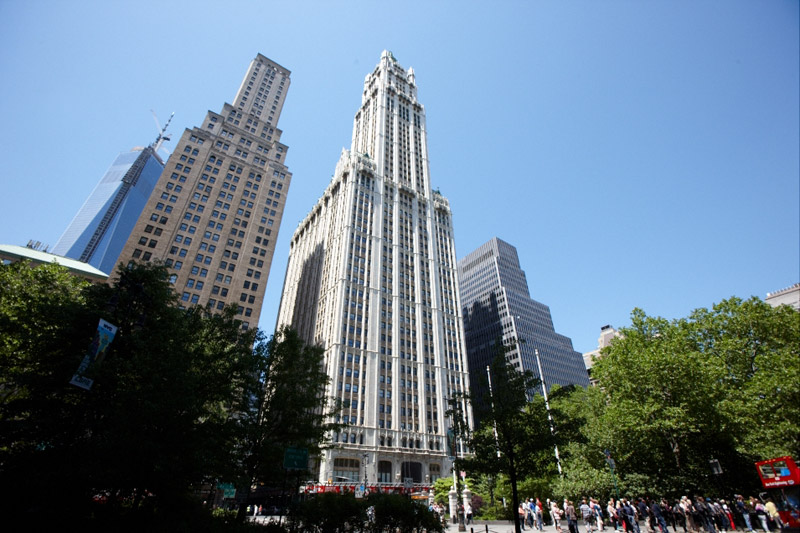By Konrad Putzier
Manhattan’s class B office buildings may soon become an endangered species.
As apartment prices skyrocket amid growing global demand, more and more office buildings are being converted into residential buildings.
Two weeks ago, the Chetrit Group filed plans to convert part of the Sony Building at 550 Madison Avenue in Midtown from office space to 96 condominiums.
The Woolworth Building
The units will join a growing number of former commercial towers turned residential, headlined by the Woolworth Building, where Alchemy Properties is converting the top 30 floors into 34 luxury apartments.
The 8,975 s/f penthouse at the Woolworth will ask a staggering $110 million, while three other apartments will ask more than $20 million.
Few other office-to-residential conversions can command similar prices, but brokers and appraisers agree that the higher returns offered by condo sales are the main reason for the conversion trend.
“The returns on residential development — especially because the focus has been on luxury — make a residential conversion competitive with commercial use,” explained Jonathan Miller, of appraisal firm Miller Samuel.
“The focus seems to be on converting everything that’s not tied down to residential. We are in this window where development opportunities are being explored in all property types.”
The high prices of Manhattan development sites make conversions more profitable than new construction in many cases, explained Gary Malin, president of residential brokerage Citi Habitats. “If you buy at the right price point, (conversions) will often save the owner money. There’s a lot of upside,” he said.
The growing number of conversions is part of a national trend. In late 2013, a report by research firm CoStar noted that in the current cycle “developers are not just looking to demolish or convert lower-quality office buildings. They’re also repositioning higher quality office properties to meet growing demand for urban residential space.”
The report added that this trend is particularly prevalent in Midtown Manhattan, where condos can sell for as much as $5,000 per s/f, “far exceeding the going rate for even high-quality office buildings.”
Office-to-residential conversions aren’t just taking place in famous high-rise buildings like the Woolworth or Sony buildings, but in class B office space across Manhattan’s commercial districts.
Another conversion hotbed is the Financial District, where old office space abounds and residential rents have been rising amid the district’s emergence as a 24-hour neighborhood.
Elliot Bogod
Elliot Bogod, of the downtown-focused brokerage A&I Broadway Realty, has sold units at Africa Israel’s conversions at 20 Pine Street and 15 Broad Street, among others. He explained that the apartments have few reminders that the buildings once housed offices.
“Clients like those ceiling heights and large windows,” he said, adding that amenities such as swimming pools and 20 Pine Street’s Turkish Hamam bath add to the appeal.
Pre-war commercial buildings have the additional advantage of offering a vintage charm that is hard to replicate in new construction.
The Cast Iron House, a 13-unit condo building at 67 Franklin Place in Tribeca, is a Shigeru Ban-designed conversion of a 19th century clothing manufacturing building.
Danika Dorsey of Corcoran Sunshine, the project’s sales director, said the building’s large windows and its landmarked, cast-iron façade add to the building’s appeal.
“What I’m seeing from buyers is that this building offers the best from both worlds. It allows them to experience a bit of New York history,” she said. Sales for the building’s 11 duplex units and two penthouses launched in April, with prices ranging between $5 million and $15 million.
But for all their advantages, office-to-residential conversions also pose several challenges. One is the cost of construction, which can be significant and depress returns to the point where maintaining office space is more profitable.
Westchester-based Caspi Development recently bought a 20,000 s/f office building at 161 Bowery in the Lower East Side, and zoning would have allowed for a conversion to condos. But despite the neighborhood’s growing residential appeal, principal Joshua Caspi told Real Estate Weekly that the costs associated with conversion proved an obstacle.
Instead, the company decided to renovate the floors and create modern office space geared towards tech tenants.
Another significant obstacle is that floor plans in office buildings sometimes aren’t ideally suited for residential buildings.
Broadway Realty’s Elliot Bogod explained that office buildings tend to have more hallways and corridors, which tends to diminish the useable residential space.
A lack of light is another common complaint, as Douglas Elliman broker Victoria Shtainer learned when she listed an apartment at 15 Broad Street. “It was not pretty. There was only one window. Spaces were huge, but they were not suitable because of the light issue,” she said.
“People liked it because of its good price per square foot, but the apartment was not so comfortable. There is just very little light.”
Whether an office-to-residential conversion becomes a success or a failure depends in part on how a developer makes use of a building’s specific attributes, argued Citi Habitats’ Gary Malin.
“It takes people that understand the inner workings of buildings,” he said. “It’s like a jigsaw puzzle, and it all depends on how you can put the pieces together.”
Difficult or not, most observers agree that more office space is bound to be converted into condos in the future.
“This trend will continue as long as there’s new development activity,” said appraiser Jonathan Miller. “New opportunities for development are going to expand and draw space away from commercial use unless there is a significant uptick in commercial rents.”



